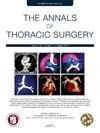Long-Term Outcomes of Magnetic Sphincter Augmentation: A Comparative Study to Nissen Fundoplication
IF 3.6
2区 医学
Q1 CARDIAC & CARDIOVASCULAR SYSTEMS
引用次数: 0
Abstract
Background
Magnetic sphincter augmentation (MSA) demonstrates improvement in gastroesophageal reflux disease (GERD) across multiple short-term studies. Long-term, single-arm studies show durable outcomes, but there is limited comparative data to Nissen fundoplication (NF).
Methods
We performed a retrospective propensity-matched cohort study of patients with GERD undergoing MSA or NF between 2012 and 2018. Patients were matched on age, sex, body mass index, size of hiatal hernia, length of Barrett esophagus, and motility in a 1:1 fashion. A total of 523 patients (177 MSA, 346 NF) underwent surgery and after matching 177 MSA and 177 NF cases were analyzed.
Results
At 1 year, GERD quality of life scores improved (22 to 5 MSA vs 24 to 5 NF, P = .593). Proton pump inhibitor use was 14% vs 5% (P = .010). pH testing demonstrated improved DeMeester scores (42 to 21 vs 46 to 7, P < .001). At 5 years, GERD quality of life scores were stable (5 to 5 vs 5 to 4, P = .208). Proton pump inhibitor use was 31% vs 26% (P = .474). The incidence of endoscopic dilation was similar between MSA and NF (7% vs 10%, P = .347). Reoperation rates were higher for MSA (10% vs 4%, P = .022) and recurrent hiatal hernias were found in 18% vs 7% (P = .007). Compared to NF, MSA undergoing complete dissection showed no difference in dilation (5% MSA vs 7% NF, P = .527), reoperation (8% MSA vs 6% NF, P = .684) or hernia recurrence (10% MSA vs 6% NF, P = .432).
Conclusions
MSA achieves similar improvements in quality of life and freedom from medical therapy compared to NF, especially with complete hiatal repair.
磁性括约肌增强术的长期疗效:与尼森胃底折叠术的比较研究。
背景:多项短期研究显示,磁性括约肌增强术(MSA)可改善胃食管反流病。长期、单臂研究显示疗效持久,但与尼森(NF)的比较数据有限:我们对 2012 年至 2018 年期间接受 MSA 或 NF 治疗的胃食管反流病患者进行了一项倾向匹配队列回顾性研究。患者的年龄、性别、体重指数、食管裂孔疝大小、巴雷特长度和运动能力以1比1的方式进行匹配。共有523名患者(177名MSA,346名NF)接受了手术,匹配后对177名MSA和177名NF进行了分析:1年后,胃食管反流病患者的生活质量评分有所提高(MSA为22分至5分,NF为24分至5分,P=0.593)。pH值测试显示 DeMeester 评分有所提高(42 分至 21 分 vs 46 分至 7 分,p=0.010):与 NF 相比,MSA 在生活质量和免于药物治疗方面取得了相似的改善,尤其是在进行完全食道裂孔修复的情况下。
本文章由计算机程序翻译,如有差异,请以英文原文为准。
求助全文
约1分钟内获得全文
求助全文
来源期刊

Annals of Thoracic Surgery
医学-呼吸系统
CiteScore
6.40
自引率
13.00%
发文量
1235
审稿时长
42 days
期刊介绍:
The mission of The Annals of Thoracic Surgery is to promote scholarship in cardiothoracic surgery patient care, clinical practice, research, education, and policy. As the official journal of two of the largest American associations in its specialty, this leading monthly enjoys outstanding editorial leadership and maintains rigorous selection standards.
The Annals of Thoracic Surgery features:
• Full-length original articles on clinical advances, current surgical methods, and controversial topics and techniques
• New Technology articles
• Case reports
• "How-to-do-it" features
• Reviews of current literature
• Supplements on symposia
• Commentary pieces and correspondence
• CME
• Online-only case reports, "how-to-do-its", and images in cardiothoracic surgery.
An authoritative, clinically oriented, comprehensive resource, The Annals of Thoracic Surgery is committed to providing a place for all thoracic surgeons to relate experiences which will help improve patient care.
 求助内容:
求助内容: 应助结果提醒方式:
应助结果提醒方式:


